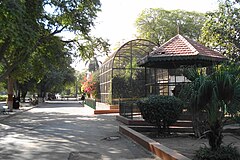Karachi Zoo
 |
|
| Date opened | 1878 |
|---|---|
| Location | Nishter Road, Sir A.K. III Road, Karachi, Sindh, Pakistan |
| Coordinates | 24°52′34″N 67°01′24″E / 24.876228°N 67.023203°ECoordinates: 24°52′34″N 67°01′24″E / 24.876228°N 67.023203°E |
| Land area | 33 acres (130,000 m2) |
| No. of animals | ~880 |
| No. of species | ~80 |
| Annual visitors | 2.3 million (2001) |
| Website | http://www.karachizoo.pk/ |
Karachi Zoo (Urdu: کراچی چڑیاگھر) also known as Karachi Zoological Garden is located in Karachi, Sindh, Pakistan. It is the largest zoo of Pakistan and second oldest zoo in the country after Lahore Zoo.
Karachi Zoo, established in year 1878, was commonly called as 'Mahatma Gandhi Garden' (Urdu: باغ مہاتما گاندھی). In 1861, the zoo was transferred to municipality by the government. In 1878, the municipality placed the zoo under a trust to be developed out of public subscription. Later, the zoo was once again opened to public in 1881. After the independence of Pakistan in 1947, the name was changed to 'Karachi Zoological Gardens' or 'Karachi Zoo' for short. In 1953, Karachi Metropolitan Corporation introduced a zoo curator and a qualified veterinary doctor. In 1991-2 CDGK for remodelling of Natural History Museum, which was carried out. In 1992, the Japanese Princess inaugurated the remodeled Natural History Museum. Currently, total strength of Karachi Zoo is about 240 staff members.
Karachi Municipal Aquarium was constructed in 1953. Located inside the Karachi Zoo, the aquarium has a total of 28 tanks which contain a total of around 300 fishes of about 30 species. It is one of the three public aquaria in Karachi, the other two being Clifton Fish Aquarium and Landhi Korangi Aquarium.
The treatment and conditions of the animals in the zoo has been criticized in the Pakistani media.
Another reason Karachi Zoo has developed a negative reputation because of multiple deaths of resident species of Arabian oryx, classified as critically endangered by IUCN. A pair was bought from a private farm in 2007. The female gave birth to a female in 2007 and later, to a male and a female in 2008, both of which died in 2009. The first-born oryx gave birth on March 12, 2010 to another calf, who died the following day. Four days later, the mother of the calf also died in the zoo hospital. At that point, the zoo was left with the original pair from 2007. On March 23, 2010, the female of the pair, who was being treated for a foot injury at the zoo hospital for a week, also died.
...
Wikipedia
